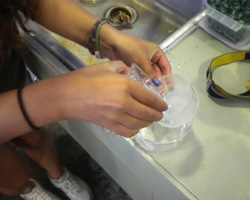 Featured Research
Student Researcher Madaly Alcala Investigates the Man-Made Salt Marsh
Just a short walk from Cabrillo Marine Aquarium is Salinas de San Pedro, a 3.75-acre man-made salt marsh. The marsh was built in 1985 by the Port of Los Angeles to mitigate for habitats lost to coastal development. Cabrillo Marine Aquarium student researcher Madaly Alcala and senior at San Pedro High School wanted to know: Is this man-made salt marsh serving as a natural nursery of the ocean?
To find the answer, she compared the biodiversity of meroplankton from Salinas de San Pedro to the nearby boat launch. Meroplankton refers to animals in their early stages of life including many species of larval fish, larval crabs and larval shrimp, excellent indicators of a thriving natural nursery.
“My hypothesis was that the man-made salt marsh would have a higher biodiversity than the coastal area around it due to its environmental attributes, such as being somewhat sheltered and having a low turbidity,” explained Alcala. (Turbidity is a measure of water clarity. A high turbidity measurement indicates high amounts of suspended solids while low turbidity indicates low amounts of suspended solids.)
During a period of eight weeks, Alcala preformed 12 trials, six at the salt marsh and six at the boat launch. “I would go out to the marsh and go out to launch the same time of day and do a plankton tow,” she said. Then she was off to the Aquatic Nursery to identify plankton from the tow under a microscope.
“I think that was the hardest part, identifying all the plankton because I went into the internship without a background in marine biology,” said Alcala. “I bought a book and taught myself how to identify plankton, so after a week of the internship I was able to identify the different species and families.”
Once all the trials were completed, all the species of meroplankton identified and all the numbers crunched, the result was: Plankton at the launch was slightly more biodiverse than plankton from the salt marsh. This indicated the opposite of Alcala’s hypothesis, but she wasn’t disappointed because there was a sewage spill in the salt marsh just a week before she started her project.
“In the salt marsh, there were close to zero meroplankton after the sewage spill and the population gradually increased during the eight weeks,” explained Alcala. “But I don’t have data from before the spill, so I can’t say for sure that the salt marsh had greater biodiversity. I have to base my conclusion on the measurements I have.”
Her research project placed second at the Los Angeles County science fair in animal biology. This fall Alcala will be attending UC-Berkley as a molecular marine biology major. “Before the CMA internship I wanted to study trees, but studying plankton literally changed my life because now I’m interested in marine biology,” she said. “Pretty much everything about plankton makes me love it.”
Share



|
|

